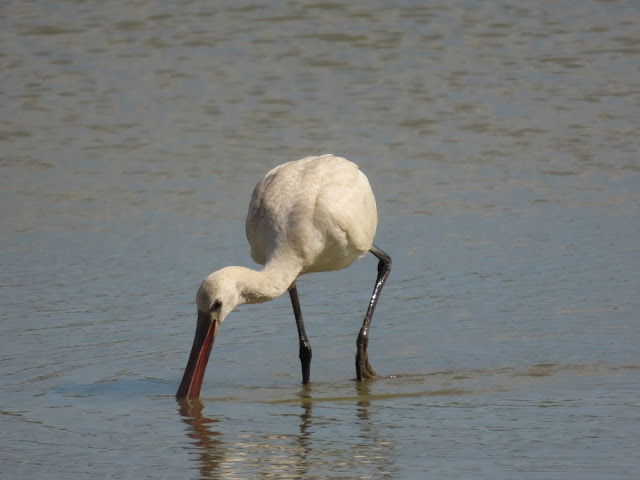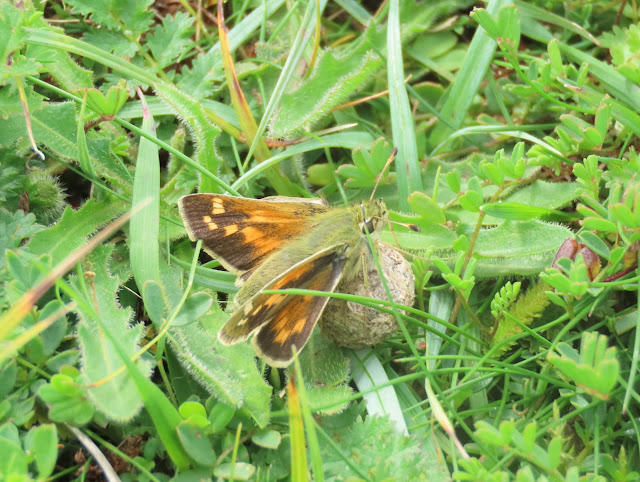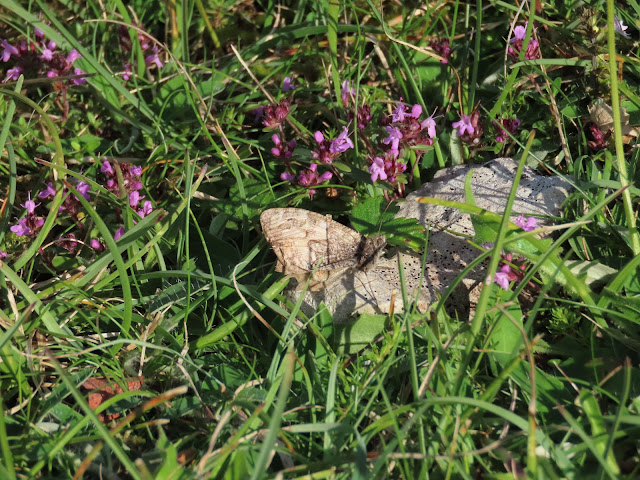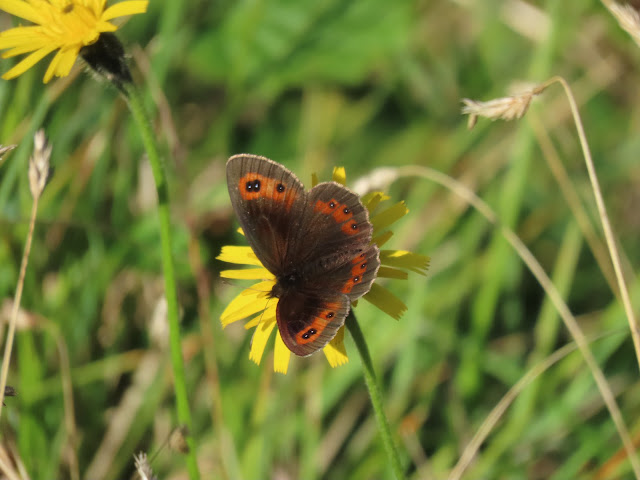With only seven more of the UK’s 59
butterfly species, still to see, four of them being in the north of
England, I was pleased when someone happened to mention that Scotch
Argus butterflies would be flying at the beginning of August. I had
always assumed their flight period occurred during school term time.
With a family holiday booked for mid August, I wondered if I could
fit in a trip to Arnside Knott, on the south side of Morecambe Bay,
Lancashire, at the beginning of August. This is one of two limestone
grassland sites where Scotch Argus butterflies can be found south of
the border with Scotland, the other being slightly further north at
Smardale Gill.
Looking at the distances involved , I
reckoned I could drive for three hours at a time, so worked out that
I could fit in a visit to one of the WWT Centres, at Martin Mere, on
the way, before continuing north for a further hour or so. This would
be the fifth WWT Centre I’ve visited as I have already been to
centres at London, Slimbridge, Llanelli and Welney. (There are ten
in total.) I found a small
cottage in a village close to Leighton Moss RSPB which is in the same
area as Arnside Knott. It was available
for two nights so I booked it together with a Premier Inn at Ormskirk
on the way home.
Although slightly apprehensive about
the length of the journey, I started out at 5.30 on Wednesday
morning, and arrived at Martin Mere at 8.35. after a good run, though
I came through some heavy rain. The centre did not open until 9. 30
so I drank my flask of coffee and read a book I had with me. Rather
like Slimbridge, there are two paths to follow with hides to visit en route. However, there were not that many birds of note. I added cattle egret
to my year list, though, and took an hour’s guided electric boat
ride where I learned about the history of the centre and saw some sparrow hawk juveniles flying with an adult. I was also
surprised to see some whooper swans which had remained all summer so
far. Some captive Bewick swans were rearing cygnets and a common whitethroat was showing well as it pecked at blackberries on a bridge.
Bewick swan family
harrier hide
view from electric boat, some of the branches are reflections!
common whitethroat
view from hide
cattle egrets and a little egret
wall butterfly
Next day started bright and sunny, and it
looked like staying that way for most of the day, which was good, as
I had planned a day looking for butterflies. I got to Arnside Knott
around 8.45 am, hoping that the early sun would encourage some species
to fly. I had looked up a route recommended by the National Trust ,who
own the site, and decided to follow it. A couple of other people were also
getting out of the car, and I found out that they, too were looking
for butterflies. I decided it would be useful to stay within
shouting distance of them, as they might find something I hadn’t
seen!
The first
butterfly of significance was a grayling, first of this species this
year for me. There were also common and holly blues, brimstone,
small heath, meadow brown and gatekeepers. Eventually I came out on
a more open area and there I found my first ever Scotch Argus butterfly
just as one of the other butterfly spotters gave a shout to say he’d found one
too. I watched the dark brown butterfly as it flew fairly close to the ground, however, when it rested it always hid amongst the grasses. Eventually one of the butterflies rested, open winged on a flower
which allowed some nice photographs, showing its dark brown wings
with reddish/orange bands with multiple eye spots. We only
saw those two Scotch Argus butterflies although I read later, over 30
had been seen at Smardale Gill! One surprise sighting was a beautiful
fresh female brown hairstreak feeding on hemp agrimony which one of
the other butterfly spotters happened to see, although he had no idea
what it was to start with! Its orange underwings showed up brightly
in the sun and provided an opportunity for some reasonable photos. Apart
from butterflies, the views from the hill over Morecambe Bay were
wonderful, a huge expanse of water which seem to stretch from left
to right as far as you could see with the hills of the Lake district in the distance. Although I continued looking I
didn’t find any other species of the northern butterflies, I had
hoped possibly to find. I think their flight season may have
finished earlier.

Views from Arnside Knott - Lake District mountains in distsance
grayling
Scotch argus
At Meathop Moss I had wanted to see Large Heath,
but although I walked around the board walks three times (!) there
were none. I did see a dozen or so lizards sunbathing on the
boardwalk, quickly disappearing over the edge as I approached.
board walk at Meathop Moss
I managed to fit in a few other nature
reserves that day, including Foulshaw Moss where a pair of ospreys
have bred, and Warton Crag, a disused quarry which has been made into
a nature reserve, again with some lovely views if you follow a
footpath to the top and another good area for butterflies. When about to
leave the quarry, someone told me that not far away the rspb Morcambe Bay reserve which consists of a couple of hides, an extension of Leighton Moss rspb had some
spoonbills there at that moment, and suggested I might like to visit
which I did, as I still needed them for my birding year list! A
group of greenshank there, provided me with another year tick too.
Warton Crag quarry
Next day was more cloudy to start with and
I went round to rspb Leighton Moss as it opened. I was a little
disappointed here as there were few birds of note around , and I felt
I spent more time walking between the hides than sitting in them! I
saw three female red deer at the edge of some woodland but not the
otters which sometimes show. Most interesting was a great white
egret, though there were the usual ducks and swans and the feeders
were busy with garden birds.
For anyone interested , the butterflies, I yet have to see are as follows:
- Large heath
- Mountain ringlet
- High brown fritillary
- Lulworth skipper had booked a 2 day break to see this but cancelled as forecast unsuitable weather
- Chequered skipper- tried on two occasions at Fineshade wood but so far unsuccessful
- Northern brown argus


























































.JPG)
